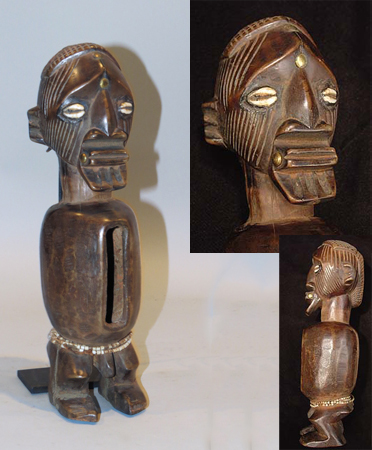
Owner: HWMC
Catalog#: AF-IDST-140-14
Slit Drums
Teke Slit Drum
Democratic Republic of the Congo
Teke
Wood, fiber rope, cowrie shells, brass, shell beads
Mid 20th century
Length: 13.5 inches
Idiophone – Struck Directly – Slit Drum
The Teke live on the banks of the Congo River, a territory lying across the Republic of Congo, the Democratic Republic of Congo and Gabon. The word Teke means ‘to buy’ in the Bateke language, therefore the name is presumably derived from the fact that they were merchant traders dealing specifically in maize, millet, and tobacco.
They are a very spiritual people believing in practicing African traditional religion, which involves spirits and the protection of ancestors. The Teke have two basic types of statues: the Nkida which do not have a magical charge, and the Butti which do.
The Nkida statues represent an important person (ancestor) that has passed on (hunter, father, mother, fisherman, warrior, etc.) These statues are uniquely representative and do not carry a magical charge as do the Butti statues. Among the Teke, the cult of the ancestors is very important. The ancestors live in the sacred forests, near rivers, in clearings, and in caves. If the descendants do not honor their ancestors, they believe that they will come back to torment them, be it with sickness, or mental illness.
This finely carved figural (nkida) slit drum displays a male with a pronounced goatee and well combed hair. Vertical, line-shaped scar tattoos cover large parts of the face, along with brass nails on the forehead and both sides of the mouth. Cowrie shells for eyes also adorn this slit drum. Around the waist at the bottom of the resonator are two rows of shell-cut beads. Unlike the fetish butti power-figure this slit drum does not have the wrapped fabric and mineral substances inside the navel area. It was used to signal during ritual events honoring the ancestor. Signs of usage and age.
